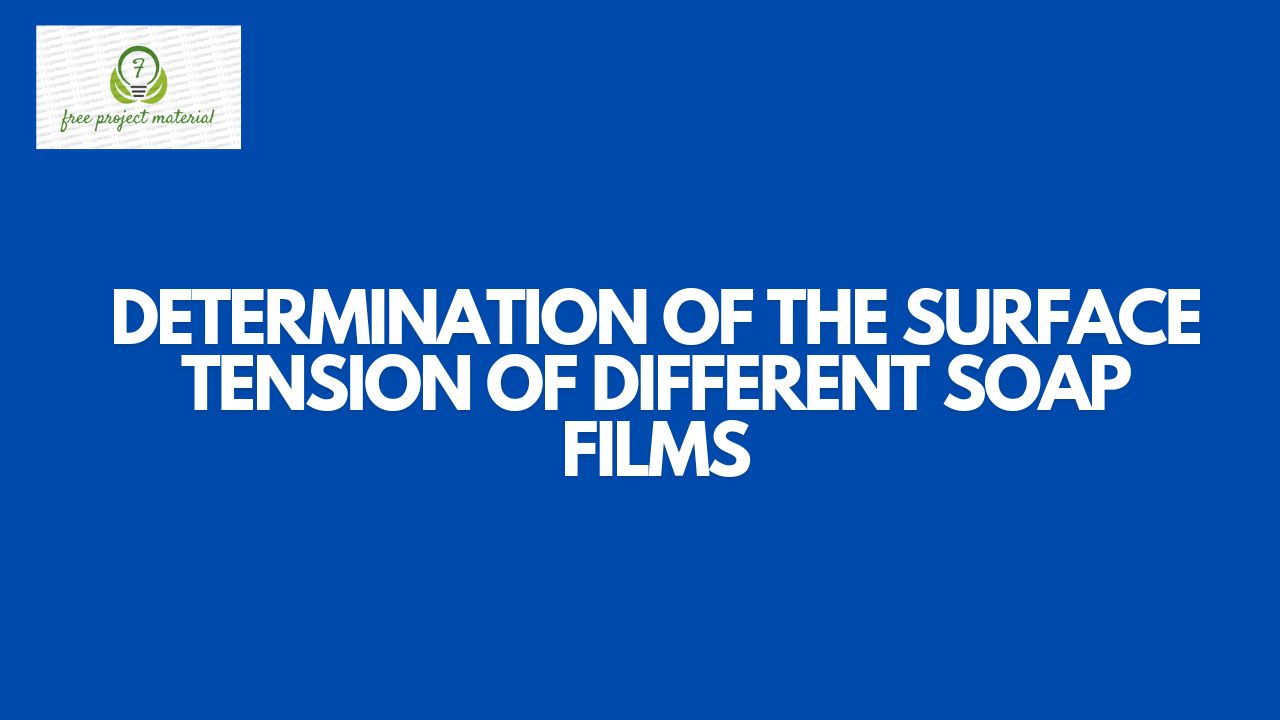ABSTRACT
Surface tension is the force that causes the surface of a liquid to act like a stretched elastic skin. It is measured in N/m. surface tension is very unique yet some organisms use it to their advantage. Cohesive force causes the tension and is responsible for the shape of water drops. Surface tension can be used in the production or manufacturing of rainproof and is important as it is a good indicator if any change are occurring in the formulation. Surface tension was determined using soap film method, the results show that sample A had the highest ability to form lather, followed by sample B, sample D and sample C and the value range from (0.0031 – 0.0647) N/m, (0.0023 – 0.0612) N/m, (0.0026 – 0.059) N/m and (0.0017 – 0.0154) N/m.
TABLE OF CONTENTS
Title page – – – – – – – – i
Certification – – – – – – – ii
Dedication – – – – – – – – iii
Acknowledgements – – – – – – iv
Abstract – – – – – – – – v
Table of Contents – – – – – – – vi
1.0 CHAPTER ONE: INTRODUCTION
1.1 Background of the Study – – – – – – 1
1.2 Aim and Objective of the Study – — – – – 4
1.3 Scope of the Study – – – – – – – 4
1.4 Limitation of the Study – – – – – – 5
1.5 Definition of Terms – – – – – – 5
2.0 CHAPTER TWO: LITERATURE REVIEW
2.1 Surface Tension and its Measurement – – – – 7
2.2 Capillary and Angle of Content – – – – – 9
2.3 Application of Surface Tension – – – – – 13
2.4 Importance of Surface Tension – – – – – 13
2.5 Causes and Effects of Surface Tension – – – 14
2.6 Dynamic Surface Tension – – – – – 16
2.7 Methods of Reducing Surface tension – – – – 16
2.8 Force Tensiometry – – – – – – 17
2.9 Stability of Soap Films – – – – – – 18
2.10 Colours and Drainage of a Soap Film – – – – 18
2.11 Bursting of a Soap Film – – – – – – 19
3.0 CHAPTER THREE: MATERIALS AND METHODS
3.1 Materials – – – – – – – – 21
3.2 Methods – – – – – – – – 22
3.3 Theory – – – – – – – 23
4.0 CHAPTER FOUR: RESULTS AND DISCUSSION
4.1 Results – – – – – – – – 25
4.2 Discussion – – – – — – – 27
5.0 CHAPTER FIVE: SUMMARY, CONCLUSION AND RECOMMENDATION
5.1 Summary – – – – – – – – 29
5.2 Conclusion – – — – – – – – 30
5.3 Recommendation – – – – – – 30
References
CHAPTER ONE: INTRODUCTION
1.1 Background of the Study
Soaps and detergents have been known to mankind for quite a long time now.
The earliest known evidence of soap use are Babylonian clay cylinders dating from 2800 Bc containing a soap-like substance.
A formular for soap consisting of water, alkali and cassia oil was written on a Babylonian clay tablet around 2200 Bc.
The Elbers papyrus (Egypt, 1550 Bc) indicates that ancient Egyptians bathed regularly and combined animal and vegetable oil with alkaline salts to create a sop-like substance.
A soap factory with bars of scented soap was found in the ruins of pompeli (7g AD) legend has it that soap gets its name from mount sapo where ancient Romans sacrificed animals.
Rain would send a mix of animal tallow and wood ash down the mountain and into the clay soil on the banks of the Tiber.
Surface tension very mysterious yet some organisms use it to their advantage such as the water strider.
The water strider is a bug that glides on water with surface tension.
Examples surface tension are beads of water on leaves, dripping water from sinks, and even lava lamps.
Soap is a salt of a fatty acid. Soaps are mainly used as surfactants for washing, bathing, and cleaning, but they are also used in textile spinning and are important components of lubricants.
Soaps for cleaning are obtained by treating vegetable or animal oils and fats with a strongly alkaline solution.
Eventually, woman noticed that it was easier to clean clothes with this soap.
(Gratton and Oss, 2004) know the forces and holes in liquid surfaces and soap films.
The phenomenon was first studied by (Dettre and Johnson in 1964) using rough hydrophobic surface.
Their work developed a theoretical model based on experiment with glass beads coated with paraffin.
The self cleaning property pf super hydrophobic micro-nanstructured surfaces was studied by (Barthloth and Ehler, 1977).
Surface tension is a phenomenon in which the surface of a liquid where the liquid is in contact with gas, acts like a thin elastic sheet.
This term is typically used only with the liquid surface is in contact with gas (such as thear).
If the surface is between two liquids (such as water and oil) it is called interface tension (Brown in 1986).
The Phenomenon of Surface Tension Can be Express in the Following Ways;
- If a wire is dipped in a soap solution, a fil of the solution may be formed across it.
- When a brush is dipped inside water or point and is brough out, all the strands cling together.
- If mercury is dropped over a clean glass surface, the mercury appears to be in a close spherical shape.
- Soap bubbles and films may be used to demonstrated the existence of surface tension.
- A pin, when placed gently on a water surface floats and the expression on the surface behaves like a stretches membrane.
- Insect e.g water skaters are able to work across water surface due to surface tension.
- When water is allowed to drop slowly from a water tap the shape of each small drop is spherical.
1.2 Aim and Objectives
The aim and objective of this study is to determine the surface tension of different soap film using it witch will enable one to determine the soap (s) to be used in a given liquid and also in the manufacturing of rain coat or umbrella materials.
1.3 Scope of the Study
This research covers the determination of surface tension and interfacial tension of solution of surface-active agents and does not cover the chemical composition (s) of the soap.
1.4 Limitation of the Study
This is limited on the research of surface tension of different soap films and its application in the industries.
1.5 Definition of Terms
Surface tension is defined as the force per unit length on either side of the imaginary line drawn on the liquid surface at rest.
Surface tension is a contractive tendency of the surface of a liquid that allow it to resist an external force.
Example:- In the floating of some object on the surface of water, even though they are denser than water and in the ability of some insects.
Soap film:- Soap films are thin layers of liquid (usually water-based) surrounded by air.
For example, if two soap bubbles come into contact, they merge and a thin film is created in between.
Cohesion: Is the intermolecular attraction between by which the elements of a body ate hold together.
Adhension: Is the tendency of dissimilar or surface to cling to one another.
Capillarity: Is the interaction between the surface of a solid or liquid in contact that distorts the normal geometry of the liquid surface especially the rise or fall of a liquid in a fore tube.
Angle of Contact: In the angle between the meniscus and the containing walls of a column of liquid measured from the vertical wall below the surface of the liquid to the position of the tangent the meniscus at it point contact with the wall.



